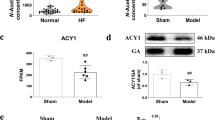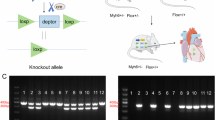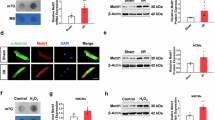Abstract
Myocardial injury and ensuing fibrotic alterations impair normal heart architecture and cause cardiac dysfunction. Oxidative stress has been recognized as a key player in the pathogenesis of cardiac injury and progression of cardiac dysfunction, and promoting fibrosis. In the current study we investigated whether luteolin-7-diglucuronide (L7DG), a naturally occurring antioxidant found in edible plants, could attenuate isoproterenol (ISO)-induced myocardial injury and fibrosis in mice and the underlying mechanisms. Myocardial injury and fibrosis were induced in mice via injection of ISO (5 mg·kg−1·d−1, ip) for 5 or 10 d. Two treatment regimens (pretreatment and posttreatment) were employed to administer L7DG (5–40 mg·kg−1·d−1, ip) into the mice. After the mice were euthanized, morphological examinations of heart sections revealed that both L7DG pretreatment and posttreatment regimens significantly attenuated ISO-induced myocardial injury and fibrosis. But the pretreatment regimen caused better protection against ISO-induced myocardial fibrosis than the posttreatment regimen. Furthermore, L7DG pretreatment blocked ISO-stimulated expression of the genes (Cyba, Cybb, Ncf1, Ncf4 and Rac2) encoding the enzymatic subunits of NADPH oxidase, which was the primary source of oxidant production in mammalian cells. Moreover, L7DG pretreatment significantly suppressed ISO-stimulated expression of collagen genes Col1a1, Col1a2, Col3a1, and Col12a1 and non-collagen extracellular matrix genes fibrillin-1, elastin, collagen triple helix repeat containing 1 and connective tissue growth factor. In addition, L7DG pretreatment almost reversed ISO-altered expression of microRNAs that were crosstalking with TGFβ-mediated fibrosis, including miR-29c-3p, miR-29c-5p, miR-30c-3p, miR-30c-5p and miR-21. The current study demonstrated for the first time that L7DG is pharmacologically effective in protecting the heart against developing ISO-induced injury and fibrosis, justifying further evaluation of L7DG as a cardioprotective agent to treat related cardiovascular diseases.
Similar content being viewed by others
Log in or create a free account to read this content
Gain free access to this article, as well as selected content from this journal and more on nature.com
or
References
Schaper J, Speiser B . The extracellular matrix in the failing human heart. Basic Res Cardiol 1992; 87: 303–9.
Whittaker P, Boughner DR, Kloner RA . Analysis of healing after myocardial infarction using polarized light microscopy. Am J Pathol 1989; 134: 879–93.
Kwong RY, Chan AK, Brown KA, Chan CW, Reynolds HG, Tsang S, et al. Impact of unrecognized myocardial scar detected by cardiac magnetic resonance imaging on event-free survival in patients presenting with signs or symptoms of coronary artery disease. Circulation 2006; 113: 2733–43.
Kwong RY, Sattar H, Wu H, Vorobiof G, Gandla V, Steel K, et al. Incidence and prognostic implication of unrecognized myocardial scar characterized by cardiac magnetic resonance in diabetic patients without clinical evidence of myocardial infarction. Circulation 2008; 118: 1011–20.
Assomull RG, Prasad SK, Lyne J, Smith G, Burman ED, Khan M, et al. Cardiovascular magnetic resonance, fibrosis, and prognosis in dilated cardiomyopathy. J Am Coll Cardiol 2006; 48: 1977–85.
Wattanapitayakul SK, Bauer JA . Oxidative pathways in cardiovascular disease: roles, mechanisms, and therapeutic implications. Pharmacol Ther 2001; 89: 187–206.
Lambeth JD . NOX enzymes and the biology of reactive oxygen. Nat Rev Immunol 2004; 4: 181–9.
Doerries C, Grote K, Hilfiker-Kleiner D, Luchtefeld M, Schaefer A, Holland SM, et al. Critical role of the NAD(P)H oxidase subunit p47phox for left ventricular remodeling/dysfunction and survival after myocardial infarction. Circ Res 2007; 100: 894–903.
Liu L, Cui J, Yang Q, Jia C, Xiong M, Ning B, et al. Apocynin attenuates isoproterenol-induced myocardial injury and fibrogenesis. Biochem Biophys Res Commun 2014; 449: 55–61.
Wipff PJ, Hinz B . Integrins and the activation of latent transforming growth factor beta1–an intimate relationship. Eur J Cell Biol 2008; 87: 601–15.
Fabian MR, Sonenberg N, Filipowicz W . Regulation of mRNA translation and stability by microRNAs. Annu Rev Biochem 2010; 79: 351–79.
Siomi H, Siomi MC . Posttranscriptional regulation of microRNA biogenesis in animals. Mol Cell 2010; 38: 323–32.
Thum T . Noncoding RNAs and myocardial fibrosis. Nat Rev Cardiol 2014; 11: 655–63.
Casanova E, Garcia-Mina JM, Calvo MI . Antioxidant and antifungal activity of Verbena officinalis L. leaves. Plant Foods Hum Nutr 2008; 63: 93–7.
Makino T, Ito M, Kiuchiu F, Ono T, Muso E, Honda G . Inhibitory effect of decoction of Perilla frutescens on cultured murine mesangial cell proliferation and quantitative analysis of its active constituents. Planta Med 2001; 67: 24–8.
Rona G, Chappel CI, Balazs T, Gaudry R . An infarct-like myocardial lesion and other toxic manifestations produced by isoproterenol in the rat. AMA Arch Pathol 1959; 67: 443–55.
Rona G . Catecholamine cardiotoxicity. J Mol Cell Cardiol 1985; 17: 291–306.
Teerlink JR, Pfeffer JM, Pfeffer MA . Progressive ventricular remodeling in response to diffuse isoproterenol-induced myocardial necrosis in rats. Circ Res 1994; 75: 105–13.
Zbinden G, Moe RA . Pharmacological studies on heart muscle lesions induced by isoproterenol. Ann N Y Acad Sci 1969; 156: 294–308.
Csapo Z, Dusek J, Rona G . Early alterations of the cardiac muscle cells in isoproterenol-induced necrosis. Arch Pathol 1972; 93: 356–65.
Kumar S, Enjamoori R, Jaiswal A, Ray R, Seth S, Maulik SK . Catecholamine-induced myocardial fibrosis and oxidative stress is attenuated by Terminalia arjuna (Roxb). J Pharm Pharmacol 2009; 61: 1529–36.
Purnomo Y, Piccart Y, Coenen T, Prihadi JS, Lijnen PJ . Oxidative stress and transforming growth factor-beta1-induced cardiac fibrosis. Cardiovasc Hematol Disord Drug Targets 2013; 13: 165–72.
Turner NA, Porter KE . Function and fate of myofibroblasts after myocardial infarction. Fibrogenesis Tissue Repair 2013; 6: 5.
Benjamin IJ, Jalil JE, Tan LB, Cho K, Weber KT, Clark WA . Isoproterenol-induced myocardial fibrosis in relation to myocyte necrosis. Circ Res 1989; 65: 657–70.
Ueha S, Shand FH, Matsushima K . Cellular and molecular mechanisms of chronic inflammation-associated organ fibrosis. Front Immunol 2012; 3: 71.
Fan D, Takawale A, Lee J, Kassiri Z . Cardiac fibroblasts, fibrosis and extracellular matrix remodeling in heart disease. Fibrogenesis Tissue Repair 2012; 5: 15.
Bouzeghrane F, Reinhardt DP, Reudelhuber TL, Thibault G . Enhanced expression of fibrillin-1, a constituent of the myocardial extracellular matrix in fibrosis. Am J Physiol Heart Circ Physiol 2005; 289: H982–91.
Teekakirikul P, Eminaga S, Toka O, Alcalai R, Wang L, Wakimoto H, et al. Cardiac fibrosis in mice with hypertrophic cardiomyopathy is mediated by non-myocyte proliferation and requires TGF-beta. J Clin Invest 2010; 120: 3520–9.
Bauer Y, Tedrow J, de Bernard S, Birker-Robaczewska M, Gibson KF, Guardela BJ, et al. A novel genomic signature with translational significance for human idiopathic pulmonary fibrosis. Am J Respir Cell Mol Biol 2015; 52: 217–31.
LeClair RJ, Durmus T, Wang Q, Pyagay P, Terzic A, Lindner V . Cthrc1 is a novel inhibitor of transforming growth factor-beta signaling and neointimal lesion formation. Circ Res 2007; 100: 826–33.
Lipson KE, Wong C, Teng Y, Spong S . CTGF is a central mediator of tissue remodeling and fibrosis and its inhibition can reverse the process of fibrosis. Fibrogenesis Tissue Repair 2012; 5: S24.
van Rooij E, Sutherland LB, Thatcher JE, DiMaio JM, Naseem RH, Marshall WS, et al. Dysregulation of microRNAs after myocardial infarction reveals a role of miR-29 in cardiac fibrosis. Proc Natl Acad Sci U S A 2008; 105: 13027–32.
Kumarswamy R, Volkmann I, Jazbutyte V, Dangwal S, Park DH, Thum T . Transforming growth factor-beta-induced endothelial-to-mesenchymal transition is partly mediated by microRNA-21. Arterioscler Thromb Vasc Biol 2012; 32: 361–9.
Wang J, Wang Y, Ma Y, Lan Y, Yang X . Transforming growth factor beta-regulated microRNA-29a promotes angiogenesis through targeting the phosphatase and tensin homolog in endothelium. J Biol Chem 2013; 288: 10418–26.
Volkmann I, Kumarswamy R, Pfaff N, Fiedler J, Dangwal S, Holzmann A, et al. MicroRNA-mediated epigenetic silencing of sirtuin1 contributes to impaired angiogenic responses. Circ Res 2013; 113: 997–1003.
Duan LJ, Qi J, Kong XJ, Huang T, Qian XQ, Xu D, et al. MiR-133 modulates TGF-beta1-induced bladder smooth muscle cell hypertrophic and fibrotic response: implication for a role of microRNA in bladder wall remodeling caused by bladder outlet obstruction. Cell Signal 2015; 27: 215–27.
van Rooij E, Sutherland LB, Liu N, Williams AH, McAnally J, Gerard RD, et al. A signature pattern of stress-responsive microRNAs that can evoke cardiac hypertrophy and heart failure. Proc Natl Acad Sci U S A 2006; 103: 18255–60.
van Rooij E, Olson EN . Searching for miR-acles in cardiac fibrosis. Circ Res 2009; 104: 138–40.
Duisters RF, Tijsen AJ, Schroen B, Leenders JJ, Lentink V, van der Made I, et al. miR-133 and miR-30 regulate connective tissue growth factor: implications for a role of microRNAs in myocardial matrix remodeling. Circ Res 2009; 104: 170–8.
Acknowledgements
This work was supported by the Program of Eastern Scholar at Shanghai Institutions of Higher Learning (Yu CHEN and Teng ZHANG), Shu Guang Project supported by Shanghai Municipal Education Commission (13SG42, Yu CHEN) and the National Natural Science Foundation of China (No 81273960, 81473732, Teng ZHANG and Yu CHEN).
Author information
Authors and Affiliations
Corresponding authors
Additional information
Supplementary information is available at the website of Acta Pharmacologica Sinica.
Supplementary information
Supplementary Figure S1
Schematic of experimental protocol. (DOC 67 kb)
Supplementary Figure S2
L7DG pre-treatment prevents the heart against ISO-induced injury. (DOC 115 kb)
Supplementary Figure S3
L7DG pre-treatment alleviated oxidative stress in in ISO-challenged hearts. (DOC 52 kb)
Supplementary Figure S4
L7DG pre-treatment decreased ISO-induced upregulation of α-SMA, TGFβ and TGFβRI in the mouse. (DOC 59 kb)
Supplementary Figure S5
L7DG pre-treatment attenuated the expression of TGFβ1 in ISO-challenged hearts. (DOC 80 kb)
Supplementary Figure S6
Comparison of the effect of L7DG pre-treatment and post-treatment regimens on myocardial fibrosis. (DOC 44 kb)
Supplementary Table S1
L7DG treatment preventively protects the heart from developing ISO-induced myocardial injury (DOC 32 kb)
Supplementary Table S2
Comparison of the morphological protection from L7DG pre-treatment and post-treatment regimens (DOC 28 kb)
Rights and permissions
About this article
Cite this article
Ning, Bb., Zhang, Y., Wu, Dd. et al. Luteolin-7-diglucuronide attenuates isoproterenol-induced myocardial injury and fibrosis in mice. Acta Pharmacol Sin 38, 331–341 (2017). https://doi.org/10.1038/aps.2016.142
Received:
Accepted:
Published:
Issue date:
DOI: https://doi.org/10.1038/aps.2016.142
Keywords
This article is cited by
-
Phase dependent sympathetic dysinnervation in Takotsubo syndrome revealed with transparent heart
Scientific Reports (2025)
-
Luteolin-7-diglucuronide, a novel PTP1B inhibitor, ameliorates hepatic stellate cell activation and liver fibrosis in mice
Acta Pharmacologica Sinica (2025)
-
P2X7 receptor is essential for ST36-attenuated cardiac fibrosis upon beta-adrenergic insult
Purinergic Signalling (2025)
-
Downregulation of lncRNA Miat contributes to the protective effect of electroacupuncture against myocardial fibrosis
Chinese Medicine (2022)
-
Evaluation of rosmarinic acid against myocardial infarction in maternally separated rats
Naunyn-Schmiedeberg's Archives of Pharmacology (2022)



